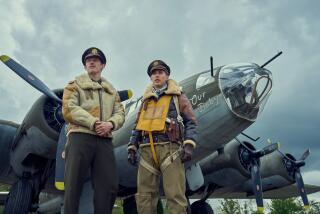Flight of the War Birds
- Share via
One day last weekend on one of those high-numbered TV stations no one watches, the GoodLife Channel was showing grainy World War II footage of the sky blackened with B-17s carpet-bombing Germany.
Good life? Certainly not for the Germans in 1945, but 55 years later, it’s a wonderful life for fans of vintage aircraft as two of the few remaining serviceable B-17s will come calling next week, one at Camarillo Airport and one in Oxnard.
The Camarillo visitor, “Sentimental Journey,” arrives Monday at noon for a four-day layover sponsored by the Confederate Air Force, a nonprofit organization of volunteers dedicated to resurrecting and maintaining the coolest flying machines of all time, those that flew from 1939 to 1945.
On Tuesday, the Massachusetts-based Collings Foundation will bring its own B-17, the “Nine-O-Nine,” to Oxnard Airport. It will be accompanied by the only flying B-24, the “All-American.”
Just before but mostly during World War II, Boeing built 12,731 of the four-engined giant B-17 bombers known as “The Flying Fortress.” The B-17 is about 75 feet long, with a 103-foot wingspan, weighing about 65,000 pounds and having a range of 1,850 miles. The Forts could reach a speed of slightly more than 200 mph and carried a crew of 10, protected by 13 0.50-caliber machine guns.
Fewer than 10 Forts are flying today.
Pat Brown, public information officer of the Camarillo Wing of the Confederate Air Force, understands the allure of these majestic old war birds.
“During the war, so many of these planes were built and so many servicemen were involved with the B-17 that most people know someone who flew them--a brother, an uncle, a father or grandfather,” she said. “Most of the pilots we have today are World War II vets, and I think being around these planes keeps them young.”
The B-17 Flying Fortresses and the B-24 Liberators were the American workhorses of the U. S. bomber force that, along with the British Royal Air Force, bombed Germany into submission but at a substantial price. The air war over Europe cost the lives of nearly 160,000 Allied airmen, plus an undetermined number of German air personnel as well as 305,000 German civilians.
The B-17 and B-24 crews had an instant war-long rivalry. The B-24 was faster and carried more bombs, but the B-17 could fly higher and withstand more damage. Flying Fortress crews laughed at the Liberator’s box-like fuselage, joking that the B-24 was actually the crate the B-17 was shipped in.
On July 18, 1941, B-17s saw their first action in Europe when they accompanied the RAF in a daylight raid over Wilhelmshaven. By the next summer, Army Air Corps personnel were swarming into England.
Allied leaders decided that the war could be won only by round-the-clock bombing of the Nazis.
The Brits preferred nighttime bombing, while the Yanks favored daytime runs because the B-17s and B-24s flying in one of Gen. LeMay’s “combat box” formations were better equipped to fight off attackers. The Luftwaffe presence, coupled with heavy flak aimed at the ponderous bombers flying in temperatures of 50 below zero, helped to create pure hell at 26,000 feet.
But it’ll be a kinder, gentler wild blue yonder next week. It’s air show season from now until November, and CAF planes will be on tour all over the country to raise money to keep the aircraft flying. What with fuel and all, it costs a few thousand bucks an hour to keep a B-17 aloft.
The Confederate Air Force’s B-17G is in mint condition with a polished aluminum body and classic painting of Betty Grable. The bomber’s visit will offer not just a tour (priced at $4) of the plane but an opportunity to take an actual flight in one of the most famous airplanes of all time.
“The flight will take about an hour, with about half an hour of actual air time flying over western Ventura County,” Brown said. “During the flight, there will be a shifting around of the passengers--so everyone will get to sit in the front and get the best view.”
One of the reasons Sentimental Journey survives is that the G model was one of the last made, and Boeing built a lot of them. The other 12,000-plus B-17 specimens weren’t as lucky.
“Most of them were left out in the desert and later scrapped,” Brown said. “A lot of them were shot down, and many more of them landed safely but were so full of holes they couldn’t be flown again. Today, there may be enough parts to build three or four more B-17s, but it’s very expensive.”
Camarillo Airport is also home to an aviation museum, a 3,000-square-foot room full of artifacts and displays, including an old-fangled flight simulator.
The museum has a C-46 cargo plane on display, but the exciting work in progress is another famous bomber, a Mitchell B-25 now being assembled and, it’s hoped, ready by 2001.
In Oxnard, the Flying Fortress and B-24 will be on display Tuesday through Friday at the Oxnard Aircraft & Jet Center at the east end of the airport.
On the ground, tours will be offered at $7 for adults and $3 for children. Flights will be available Tuesday through Thursday evenings and Friday about noon. The B-24 can take seven passengers and the B-17 eight.
DETAILS
B-17G at Camarillo Airport, 555 Airport Way, Monday-Thursday, 10 a.m.-4 p.m. Tours: $4. Flights: $350. Call: 482-0064.
B-17 and B-24 at Oxnard Airport, 2889 W. 5th St., Tuesday, 3-5:30 p.m.; Wednesday and Thursday, 7 a.m.-5:30 p.m.; Friday, 7 a.m.-noon. Tours: $7 adults, $3 children. Flights: $350. Call 648-1258 or (904) 451-9508 for information.
More to Read
Sign up for The Wild
We’ll help you find the best places to hike, bike and run, as well as the perfect silent spots for meditation and yoga.
You may occasionally receive promotional content from the Los Angeles Times.






